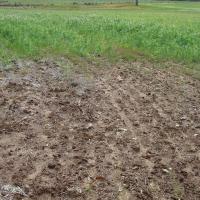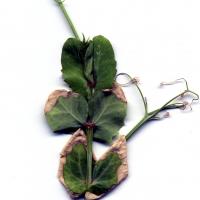Diagnosing salinity damage in field peas
Field peas are sensitive to waterlogging and moderately sensitive to soil salinity. Soil salinity affects plant growth by reducing the roots ability to extract water from the soil. Salinity damage varies from season to season due to variations in the soil salt concentration. Waterlogging increases salinity damage.
What to look for
- Symptoms vary with soil salt concentration and severity of waterlogging.
- Poor crop and weed germination (except salt tolerant species).
- Patches of apparently water stressed or prematurely dead plants in areas subject to salinity in spring.
- Dry topsoils may be crusty possibly with salt crystals on the surface .
Paddock
- Seeds swell but don't germinate or emerge, or seedlings die after emergence, particularly in wet or drying soil.
- Marginal necrosis of older leaves that progresses up the plant.
- Older leaf yellowing.
Plant
What else could it be
| Condition | Similarities | Differences |
|---|---|---|
| Diagnosing seedling root rot in field peas | Poor germination, older leaf necrosis and seedling death | Roots are necrotic and discoloured |
| Diagnosing waterlogging in narrow-leafed lupins and field peas | Germination failure, older leaf necrosis and seedling death | Plants pale, poor nodulation. |
| Diagnosing boron toxicity in field peas | Older leaf marginal necrosis | Only on highly alkaline mallee soils. |
| Diagnosing group C herbicide damage in field peas | Older leaf necrosis and seedling death | Symptoms more likely on light textured rather than saline soils. |
Where does it occur?
- Primary salinity
- Primary salinity refers to soils and landscapes that were saline in their undisturbed state, before agricultural development. Most common are aeolian morrell-blackbutt loams on the edge of major wheatbelt valleys.
- Secondary salinity
- Secondary salinity refers to soils and landscapes that have become saline since being developed for agriculture.
- Secondary salinity is caused by salt accumulation in the soil from shallow saline watertables that have developed after land clearing when shallow-rooted crops and pastures replaced deep-rooted perennials.
- Secondary - non watertable - soil salinity may result due to the accumulation of sodium and other salts in response to variable seasonal conditions and or exposure of saline subsoils
- Soils vary but are frequently duplex or heavy textured.
- Salinity is frequently accompanied by waterlogging in winter, which greatly increases plant damage.
Management strategies
- Avoid growing field peas on these soils.
How can it be monitored?
- The salinity status of a soil can be assessed from indicator plants, measuring the salt concentration in soil samples or with electromagnetic-induction instruments or by measuring the depth to a saline watertable.
See also
Further information
Page last updated: Wednesday, 13 May 2015 - 4:14pm



